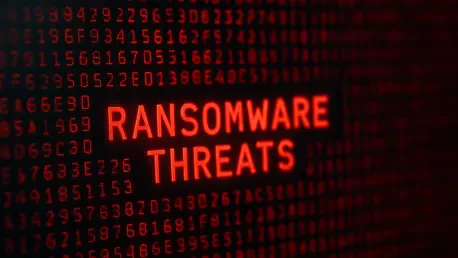Underneath the complex web of the cyber world lies a new threat—one that not only steals but irreversibly wipes data. Anubis, a formidable player in the ransomware-as-a-service (RaaS) arena, has raised alarms with its striking ability to eradicate data, leaving victims in a quandary. This menace has rapidly evolved, and its implications have become a pressing concern.
A Growing Threat Unveiled
Anubis RaaS has quickly positioned itself as a significant threat within the cybercrime ecosystem. Emerging recently, Anubis offers more than standard ransomware services; it combines a data wiper in its arsenal. This inclusion demands heightened attention due to its potential for catastrophic consequences, as it completely removes data, thereby intensifying pressure on affected organizations. The rapid increase in Anubis’s deployment signals a new phase in ransomware attacks, defining a striking move in digital extortion that surpasses predecessors.
Understanding the Stakes
As critical industries increasingly depend on data integrity and access, the stakes rise with the sophistication of ransomware attacks. Anubis’s method of data erasure amplifies risks, elevating an already intense cyber landscape to new levels of urgency. This progression places global cybersecurity at a significant juncture, with potential implications for economic stability, particularly in sectors like healthcare and finance. By weaponizing data-wiping techniques, entities that fall victim to Anubis face not only financial repercussions but also operational and reputational damage.
The Mechanics of Anubis RaaS
At the core of Anubis’s operation is a unique affiliate model that offers flexibility and versatility to its users. By adopting a dual strategy of data encryption and wiping, Anubis becomes a preferred tool for cybercriminals aiming for potent impact. Affiliates benefit from varied compensation schemes, making it a lucrative opportunity for those willing to engage. This bifurcated approach sets Anubis apart, enabling its operators to leverage data theft and destruction, thus compelling compliance with ransom demands through irreversible data loss threats.
Expert Insights and Contextual Analysis
Jon Clay from Trend Micro provides valuable insights into Anubis’s evolution, positioning it within broader cybersecurity trends. When dissecting the nature of modern threats, this ransomware stands out due to its multifaceted strategies aimed at maximizing extortion. Anubis’s tactics mirror global geopolitical influences, where state actors might exploit such tools for strategic advantage. Nation-states infamous for destructive cyber campaigns are likely to be attracted to Anubis’s capabilities, with its appeal transcending mere financial gains.
Proactive Defense Strategies
Protecting against Anubis necessitates a multi-layered defense approach. Organizations are advised to prioritize offline backups to ensure data remains accessible and secure despite potential breaches. Reinforcing employee cybersecurity training fosters a vigilant culture, reducing susceptibility to phishing and similar exploits. Implementing robust access controls limits exposure, offering a crucial layer of defense. Regularly updating and verifying security protocols further ensures resilience against evolving threats like Anubis.
In the face of escalating cyber threats embodied by Anubis, the dialogue surrounding data protection and cybersecurity resilience has gained significant urgency. This advanced ransomware represents a shift in cybercriminal tactics, underscoring the need for vigilant defenses and strategic foresight in securing digital environments.









